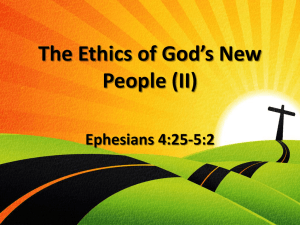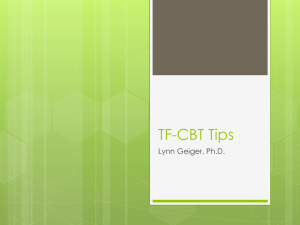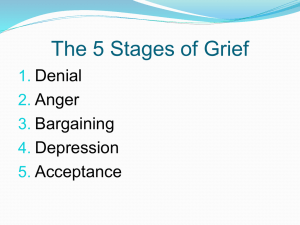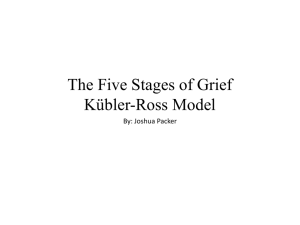John Osborne - Comune di Civitanova Marche
advertisement
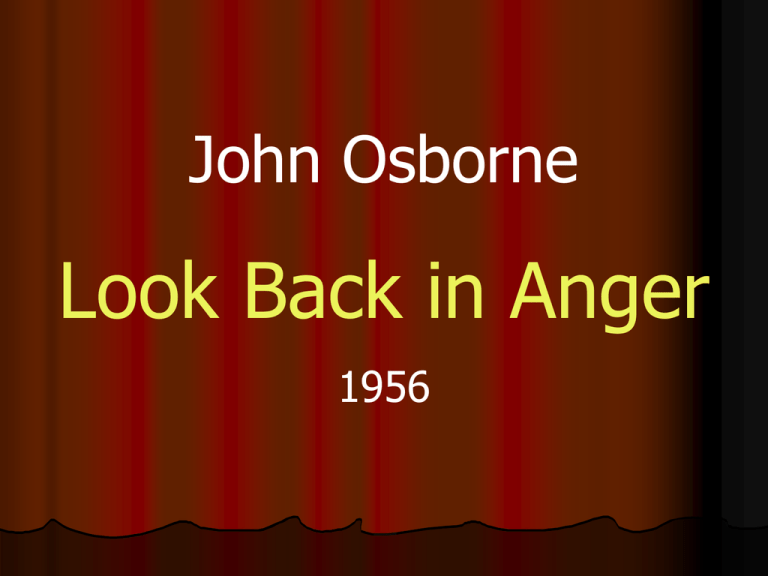
John Osborne Look Back in Anger 1956 The post-war British Theatre Founded in 50’s London It gave a first opportunity to many young dramatists who produced the kind of “noncommercial” plays. Theatre not as an escape from the issues of the time, but a way of exploring and understanding them better. John Osborne - Look Back in Anger 2 The author (1929-1994) Jon Osborne was born in London of working class parents. His father died when he was 12. He left school very early and worked as a journalist. He worked as an actor and then as a playwright. 1955 he wrote Look Back in Anger (26 years old). The play was performed in 1956 and had a great success. John Osborne - Look Back in Anger 3 Look Back in Anger: between Tradition and Innovation (page 1) The dramatic structure of the play is quite conventional and seems to follow the traditional pattern: Exposition (of the action); Development (the arriving of an outsider develops and complicates the situation); Resolution (the outsider leaves. Reconciliation of the couple). John Osborne - Look Back in Anger 4 Look Back in Anger: between Tradition and Innovation (page 2) There is also a reference to Elizabethan theatre (comedy of situation): ridiculous and incongruous situations, a heaping up of mistakes, plots within plots, unexpected meetings. But the setting, the language and the themes break with the tradition of British drama. John Osborne - Look Back in Anger 5 The structure of the play The action is a closed circle divided into 3 acts: Act 1 Exposition: Jimmy is living with Alison (who is pregnant but hasn’t told him) and Cliff. Act 2 Development: Alison, influenced by her friend Helena, leaves Jimmy. Act 3 Resolution: Jimmy is living with Helena and Cliff. Alison (who has lost her child) comes back to her husband. John Osborne - Look Back in Anger 6 The play The action is divided into 2 acts: Act 1 Scene 1: (Sunday) Jimmy is living with Alison and a friend, Cliff. Jimmy is drinking tea, Cliff is reading newspapers, Alison is ironing. Alison is pregnant and when she has found the courage to tell her husband, they are interrupted by a telephone call. It’s Alison’s friend Helena who’s going to visit her. John Osborne - Look Back in Anger 7 The play Scene 2: (Two weeks later. Another Sunday evening) Alison is getting ready to go out with Helena. Jimmy gets furious and begins a melodramatic and touching monologue about his life and his father’s death. Scene 3: (the day after) Colonel Redfern comes to bring his daughter home. He complaints about the past that is gone. Alison leaves and Helena stays. John Osborne - Look Back in Anger 8 The play Act 2 Scene 1 : (Several months later – A Sunday evening) The same scene as in act 1 but this time Helena is ironing. The three start to sing a song and dance. The gag introduces the final ending. Alison comes back. John Osborne - Look Back in Anger 9 The play Scene 2 : (A few minutes later) Helena feels guilty for Alison’s miscarriage. She understands she doesn’t love Jimmy and leaves him. Jimmy’s monologue on life and love. And they pity themselves for being in a “cruel” world “full of steel traps lying about everywhere”. They don’t solve their problems, but are still searching a way of living together. John Osborne - Look Back in Anger 10 Language Osborne avoided both the conventional upper-class diction and the dystant style of verse drama His language is immediate, genuine, taken from real life full of slang and colloquialisms. It reflects the characters’ social background (working-classes characters or upper classes characters) John Osborne - Look Back in Anger 11 Humour (page 1) There is not just linguistic humour but also comedy of situation: reference to Shakespeare Comedy of Errors. John Osborne - Look Back in Anger 12 Humour (page 2) gags between the male characters who have formed a comic duo. John Osborne - Look Back in Anger 13 The setting The setting shows domestic scenes, with stress on the banality of life (kitchen sink drama vs. fashionable settings) Identical settings in Act 1 and Act 3 and identical actions except for the substitution of the female character (a closed-circle technique). John Osborne - Look Back in Anger 14 Time dimension The symmetry of the play is emphasized by the three acts set on Sunday. Afternoon/evening: the week and the day is almost finished. The use of time reflects the dullness and repetitivity of everyday routine. John Osborne - Look Back in Anger 15 Characters: Jimmy Porter the anti-hero (page 1) Anti-hero. A man of contradictions. His complexities, inner conflicts, violent speech have become a myth for the young generation. His protest is confused and indiscriminate Motionless: he protests but doesn’t do anything to change the situation. John Osborne - Look Back in Anger 16 Jimmy Porter the anti-hero (page 2) Alienation and Loneliness. Anger for his life experience: he saw his father dying. At the end he understands the meaning of pity for another person, his wife: he’s tender with her: “Don’t. Please dont’… I can’t (…) you’re a very beautiful squirrel.” John Osborne - Look Back in Anger 17 Alison the anti-heroine (page 1) Upper class girl who left her privileges. Sick and tired of the situation. “I can’t think Criticized by Jimmy because she doesn’t express her feelings: “Oh, my dear wife, what it was to feel young, really young”. you’ve got so much to learn. If only something … something would happen to you and wake you out of your beauty sleep. If you could have a child and it would die (…) she hasn’t her own kind of passion. She has the passion of a python. She just devours me whole every time”. John Osborne - Look Back in Anger 18 Alison the anti-heroine (page 2) Feels lonely. (to Helena) “I was on my own before” Influenced by Helena: “You’ve got to fight him. Fight, or get out. Otherwise he will kill you”. “All I want is a little peace”. Anti-heroine:“I’m a conventional girl”. Finally she takes a decision by herself, she comes back and cries out her pain to her husband: “I was wrong. I was wrong! I don’t want to be a saint. I want to be a lost cause. Don’t you understand? It’s gone! It’s gone! That … that helpless thing inside my body. I thought it was safe, and secure in there. Nothing could take it from me. It was mine, my responsibility. But it’s lost. Don’t you see! I’m in the mud at last! I’m grovelling! I’m crawling! Oh God!” John Osborne - Look Back in Anger 19 Cliff Forms a comic duo with Jimmy. Cliff is the stooge. Calm and apathetic: Helena “And all the time you just sit there, and do nothing!”. Cliff “That’s right I just sit here”. At the end of the play he decides to leave and do something: have his own family. John Osborne - Look Back in Anger 20 Helena Charles Upper class like Alison but can’t share Jimmy’s world, except for a short period. To Cliff “I don’t understand him, you or any of it. All I know is that none of you seems to know how to behave in a decent, civilised way”. Active “I had to do something, dear” vs passive Jimmy who protests but doesn’t do anything to change things. She betrays her friend but she feels guilty: “Suddenly I see what I have really known all along. That you can’t be happy when what you’re doing is wrong or is hurting someone else. I can’t take part in… in all this suffering. I can’t!” John Osborne - Look Back in Anger 21 Colonel Redfern Together with Jimmy he represents the contradictions of post-war England: generation gap. Alison: “You’re hurt because everything is changed. Jimmy is hurt because everything is the same. And neither of you can face it. Something’s gone wrong somewhere, hasn’t it?” John Osborne - Look Back in Anger 22 Themes and the context Decline of patriarchal families (generation gap): a new generation was agnostic, politically committed, sexually promiscuous) Lack of communication between people (war of sexes). The class war (Social Reforms didn’t change the discrepancy between classes: the new generation was better educated but with few possibilities of success). John Osborne - Look Back in Anger 23 AYM (Angry Young Men) All this brought a sense of alienation and disillusionment: young people’s anger (Osborne and his Jimmy were among the first AYM) and lack of ideals. Jimmy: “I suppose people of our generation aren’t able to die for good causes any longer. There aren’t any good, brave causes left. “ John Osborne - Look Back in Anger 24 The anti-heroes become the real heroes of our times Life and Love. They all want to escape from the pain of being alive. And most of all, from love (…). It’s no good trying to fool yourself about love. You can’t fall into it without dirtying up your hands. It takes muscles and guts. And if you can’t bear the thought of messing up your nice, clean soul, you’d better give up and become a saint. It’s either this world or the next. John Osborne - Look Back in Anger 25 The end A cura di Rosita Giannetti John Osborne - Look Back in Anger 26
